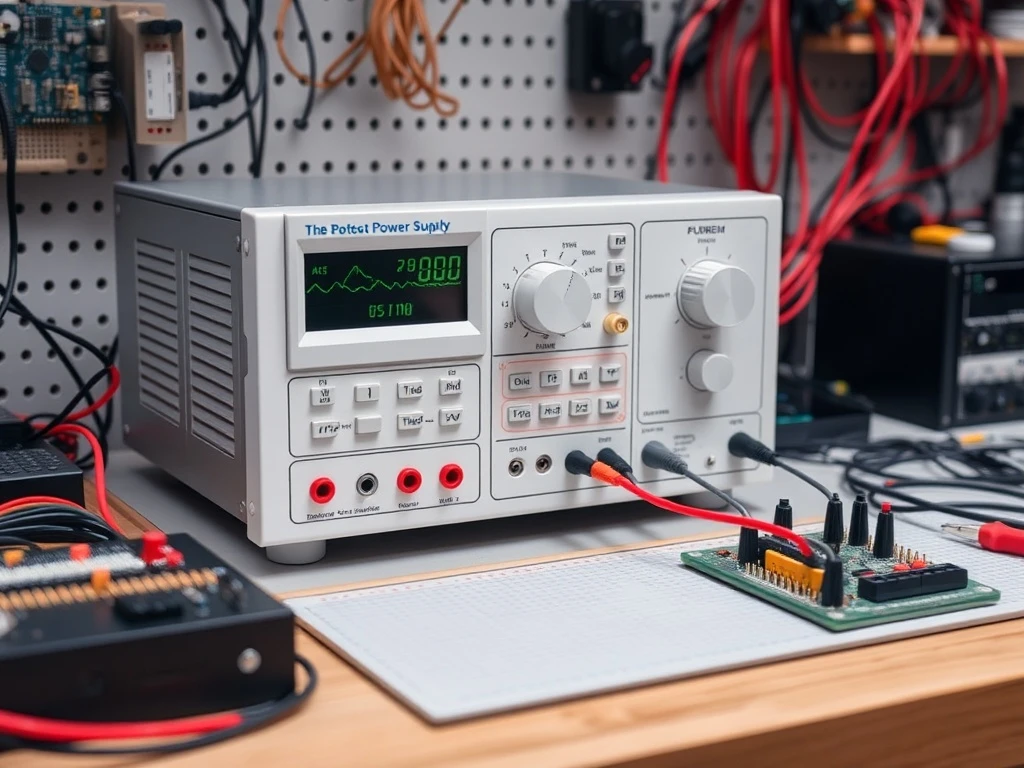Every electronics enthusiast or professional knows the value of precise power. A reliable **bench power supply** is truly indispensable. Whether you are building complex circuits or simply testing components, this tool provides essential power. The right model saves time and money. It prevents mishaps and offers the precision you need. Choosing the right **bench power supply** can feel overwhelming. Many options exist on the market. This comprehensive guide helps you narrow down your choices.
Understanding Your Power Needs: Voltage and Current for Your Bench Power Supply
Your first priority must be understanding your voltage and current requirements. If you work with test equipment or circuits, you must know each component’s power needs. Overestimating these values wastes resources. Underestimating them leads to instability or even damage. A **bench power supply** offering variable voltage and current is ideal. Start by considering the highest voltage and current your most demanding project requires. For higher-powered devices, like motors or industrial systems, you need a supply capable of higher currents or voltages. Select a model offering flexibility. This ensures you accommodate a variety of future projects. Always choose a **bench power supply** with a slightly higher capacity than your immediate needs. This provides a safety margin. It also offers room for future expansion. Consider the maximum output power (Watts). This is a crucial specification. It directly impacts the supply’s capability. For example, a 30V, 5A supply provides 150W. A 60V, 10A supply delivers 600W. Match this power rating to your typical project requirements.
Key Considerations for Voltage and Current:
- Maximum Voltage: Identify the highest voltage required by any component or circuit.
- Maximum Current: Determine the peak current draw of your most demanding project.
- Power Rating (Watts): Calculate the necessary wattage (Voltage x Current) for your applications.
- Adjustability: Ensure the **bench power supply** offers fine-grained control over both voltage and current.
Output Quality Matters: Ensuring a Clean Bench Power Supply
A stable and clean output is crucial. It ensures the proper functioning of your projects. This is especially true when testing sensitive circuits. Poor-quality power supplies introduce noise or voltage fluctuations. These lead to inaccurate measurements. Worse, they cause malfunctions in your devices. Look for a **bench power supply** offering good regulation and low ripple. Regulation refers to how well the output voltage remains steady under varying load conditions. Ripple measures unwanted variations in the output. A high-quality **bench power supply** minimizes these. It ensures a smooth and reliable output. This output will not interfere with your tests. If your work involves delicate components, such as analog devices or precision circuits, invest in a supply with particularly low ripple. Furthermore, consider transient response. This indicates how quickly the supply recovers from sudden load changes. A fast transient response prevents voltage dips or spikes. These can harm sensitive electronics. Many high-end units also feature low output noise. This is vital for RF circuits or audio applications. Always prioritize a clean output for critical projects.
Essential Safety Features for Your Bench Power Supply
Safety should never be overlooked. This is especially true when working with electrical equipment. Look for **bench power supply** models incorporating built-in protections. These include overcurrent protection (OCP), overvoltage protection (OVP), and thermal shutdown. These features safeguard both your power supply and your projects. They prevent damage from unexpected surges or faults. Overcurrent protection limits the output current. It prevents damage to the circuit under test. Overvoltage protection shuts down the supply if the output voltage exceeds a safe limit. Thermal shutdown prevents overheating. It protects the unit from internal damage. It is also important to consider the ease of monitoring and controlling the output. A display showing real-time data like voltage, current, and power is invaluable. It helps quickly identify problems or discrepancies. Additionally, ensure the supply has a reliable and easy-to-access shutdown feature. This is crucial in case of emergencies. Some advanced units offer short-circuit protection. This immediately cuts power if a short circuit occurs. This feature is highly recommended. It protects both the power supply and your valuable projects.
Interface and Usability: Choosing an Intuitive Bench Power Supply
The user interface significantly impacts your daily workflow. An intuitive **bench power supply** saves time and reduces errors. Look for clear, legible displays. Digital displays are common. They show voltage, current, and sometimes power. Consider the precision of these readouts. More digits usually mean higher accuracy. Rotary encoders or fine-tune knobs offer precise adjustments. This is crucial for sensitive circuits. Some models feature memory presets. These allow you to save frequently used voltage and current settings. This feature is incredibly convenient. It speeds up repetitive tasks. Programmable **bench power supply** units offer even greater flexibility. You can control them via software. This allows for automated testing sequences. USB or LAN connectivity enables this. For beginners, a simple, easy-to-understand interface is best. Experienced users might prefer advanced programming capabilities. Evaluate your comfort level. Choose a **bench power supply** that matches your technical proficiency. Good usability enhances efficiency. It also reduces frustration during long work sessions.
Connectivity and Advanced Features of Modern Bench Power Supplies
Modern **bench power supply** units offer more than just basic power delivery. Many include advanced connectivity options. USB, Ethernet, and GPIB ports are common. These allow remote control from a computer. Software integration streamlines testing. You can log data, automate sequences, and analyze results. Multiple output channels are another valuable feature. A dual or triple output **bench power supply** can power multiple parts of a circuit simultaneously. This is highly efficient for complex designs. Some units offer isolated outputs. This prevents ground loops and interference. It provides greater flexibility. It also enhances safety. Tracking functionality links outputs. Adjusting one output automatically adjusts others. This simplifies multi-voltage setups. Consider waveform generation capabilities. Some advanced power supplies can generate arbitrary waveforms. This is useful for simulating complex power conditions. It is an excellent feature for specialized applications. Look for models with built-in data logging. This records voltage and current over time. It helps diagnose intermittent issues. These advanced features increase versatility. They make your **bench power supply** a more powerful tool.
Form Factor and Build Quality: A Durable Bench Power Supply
The physical design and build quality of your **bench power supply** are important. A robust unit withstands daily use. Most are benchtop units. They are designed for stable placement. Consider the size and weight. Ensure it fits comfortably on your workbench. Good ventilation is crucial. It prevents overheating. Look for large heatsinks or quiet fans. A noisy fan can be distracting. High-quality components ensure longevity. A durable casing protects internal electronics. Metal enclosures are often preferred over plastic. They offer better shielding and heat dissipation. Consider the quality of the output terminals. Robust binding posts ensure good connections. They also accept various types of leads. Some portable **bench power supply** units exist. These are useful for field work or limited space. However, they often have lower power ratings. Evaluate your workspace and mobility needs. Invest in a well-built unit. It will provide years of reliable service. A solid **bench power supply** is a long-term asset.
Long-Term Viability and Investment: Future-Proofing Your Bench Power Supply
A **bench power supply** is an investment. You want it to serve you well over time. Consider future-proofing your purchase. Select a model offering room to grow with your needs. This might mean choosing a unit with higher power capabilities than your current project demands. Or, opt for a model including additional features. These could be multiple outputs or programmable settings. Also, consider the brand’s quality. Well-established manufacturers offer better durability and support. They provide firmware updates or easily accessible replacement parts. This ensures your equipment does not become obsolete too soon. Investing in a higher-quality, slightly more expensive model saves you money. It prevents the need for replacement as your projects scale up. Research brand reputation. Read user reviews. Look for warranties and customer service. A reliable manufacturer stands behind its products. This provides peace of mind. Ultimately, a smart investment in a **bench power supply** pays dividends. It supports your evolving electronic endeavors for years to come.
Types of Bench Power Supplies: Choosing the Right Technology
Different technologies power a **bench power supply**. Understanding these types helps you make an informed decision. Each type has distinct advantages and disadvantages. This impacts performance and cost. Let’s explore the main categories:
Linear Bench Power Supplies:
- How they work: They use a linear regulator. This dissipates excess voltage as heat.
- Pros: Offer very low ripple and noise. They provide excellent regulation. They are ideal for sensitive analog circuits.
- Cons: Less efficient. They generate more heat. They are generally larger and heavier. They often have lower power outputs.
- Best for: Audio applications, precision analog circuits, low-noise measurements.
Switching Bench Power Supplies:
- How they work: They convert AC to DC using high-frequency switching. This makes them highly efficient.
- Pros: Very efficient. They are compact and lightweight. They offer high power output in a small package.
- Cons: Can generate more ripple and noise than linear supplies. This might affect sensitive circuits.
- Best for: Digital circuits, high-power applications, general electronics work where efficiency and size are critical.
Programmable Bench Power Supplies:
- How they work: These can be linear or switching. Their key feature is computer control.
- Pros: Automation of tests, data logging, precise control, complex waveform generation.
- Cons: Higher cost, require software setup.
- Best for: Automated test systems, research and development, complex experimental setups.
Consider your primary use cases. This helps determine the best type of **bench power supply** for your needs. Many modern units combine features. They offer the best of both worlds. For example, some switching supplies include linear post-regulation. This reduces noise.
Calibration and Maintenance: Ensuring Longevity of Your Bench Power Supply
Even the best **bench power supply** benefits from proper care. Regular calibration ensures accuracy. Over time, components can drift. This affects voltage and current readings. Professional calibration services can re-certify your unit. This is especially important for precision work. Many manufacturers recommend annual calibration. For general use, checking against a known accurate multimeter is sufficient. Keep your **bench power supply** clean. Dust and debris can accumulate. This affects cooling and performance. Use compressed air to clean vents. Ensure adequate airflow around the unit. Avoid blocking intake or exhaust ports. Store the power supply in a dry, stable environment. Extreme temperatures or humidity can damage electronics. Check cables and connectors regularly. Replace any frayed or damaged leads. Proper maintenance extends the lifespan of your **bench power supply**. It ensures continued reliable performance. This protects your investment. It also maintains the integrity of your projects.
Choosing the right **bench power supply** is a critical decision. It impacts the success and safety of your electronics projects. Consider your specific needs. Prioritize power requirements, output quality, and safety features. Think about usability and advanced connectivity. Evaluate the build quality and long-term viability. By carefully assessing these factors, you will find the perfect **bench power supply**. It will empower your experiments. It will also bring precision to your designs. Invest wisely. Your projects will thrive.
Frequently Asked Questions (FAQs) About Bench Power Supplies
Q1: What is the primary difference between a linear and a switching bench power supply?
A linear **bench power supply** provides very clean, low-noise output. It is ideal for sensitive analog circuits. However, it is less efficient and generates more heat. A switching **bench power supply** is more efficient, compact, and delivers higher power. It is generally better for digital circuits. However, it might introduce more ripple and noise.
Q2: How do I determine the voltage and current I need for my bench power supply?
First, identify the maximum voltage required by any component in your project. Second, calculate the peak current draw for your most demanding circuit. Always choose a **bench power supply** with a slightly higher voltage and current rating than your maximum calculated needs. This provides a safety margin.
Q3: Why are safety features important in a bench power supply?
Safety features like overcurrent protection (OCP), overvoltage protection (OVP), and thermal shutdown are crucial. They protect both your **bench power supply** and your valuable projects. These features prevent damage from unexpected surges, short circuits, or overheating. They ensure a safer working environment.
Q4: Can a single-output bench power supply power multiple circuits?
A single-output **bench power supply** can power multiple circuits. You must connect them in parallel. However, all circuits will receive the same voltage. The total current draw must not exceed the supply’s maximum current rating. For projects requiring different voltages, a multi-output supply is more convenient.
Q5: How often should I calibrate my bench power supply?
For precision work, professional calibration is often recommended annually. For general hobbyist use, checking your **bench power supply** against a known accurate multimeter periodically is usually sufficient. Calibration ensures the accuracy of your voltage and current readings over time.
Q6: What does ‘ripple and noise’ mean for a bench power supply?
Ripple refers to small, unwanted AC voltage variations present on the DC output. Noise includes high-frequency spikes. Both indicate the quality of the DC output. Lower ripple and noise values mean a cleaner, more stable power source. This is vital for sensitive electronics. A clean **bench power supply** ensures accurate measurements and reliable circuit operation.






















